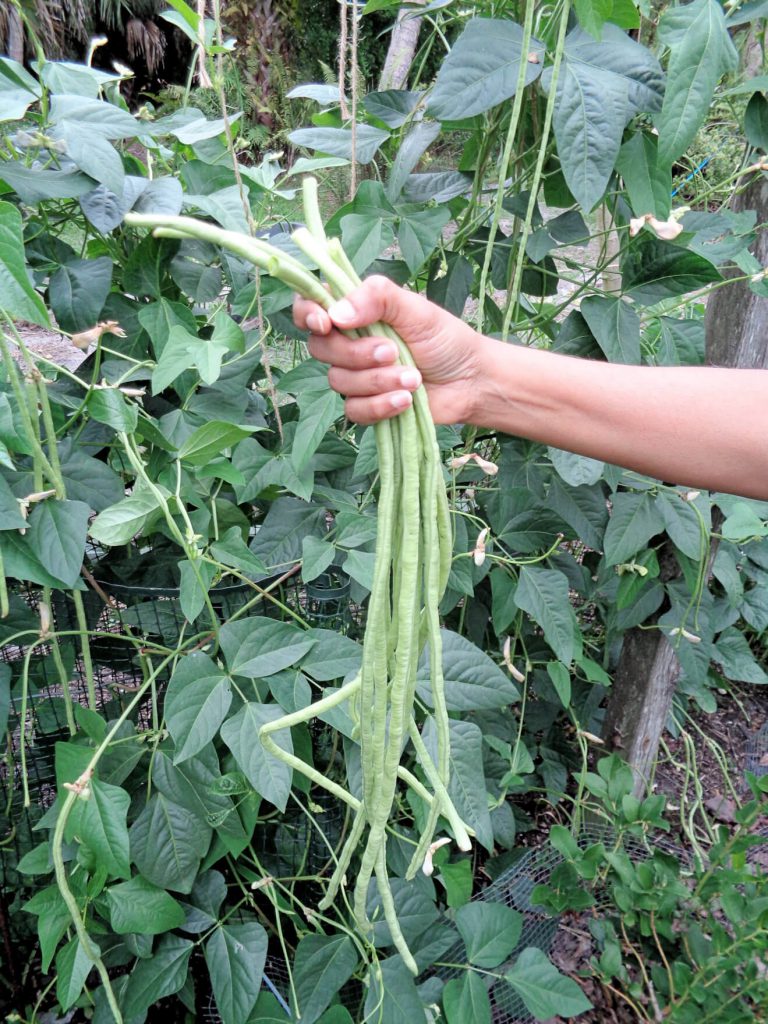
What do you call the vegetable known as the yard-long bean? Do you call it asparagus bean, Chinese long bean, long-podded cowpea, long bean, bora, bodi, pea bean, or snake bean? Whatever name you know this legume by, I am picking it in my garden right now! Available on seed racks everywhere, the yard-long bean does well as a heat-tolerant vegetable for our area. How does the yard-long bean measure up in your garden?
Related to our Southern peas or cowpeas, there are several types of yard long beans including those with light green and dark green pods. There are also red-podded varieties, and all types have pods that are at least eighteen-inches long – some grow up to four-feet long! Best grown in average, well-drained, compost-enriched soil in full-sun sites, vines can quickly develop up to twelve-feet long. As such, a trellis of at least six to seven-foot tall will need to be built to accommodate the vigorous vines. In place of a trellis, you could construct a tripod with poles and netting which makes an excellent smaller planting unit. Direct seed this bean one-inch deep and six to twelve-inches apart, with rows spaced three to four-feet apart. A row planted in a raised bed made by simply mounding soil, or using a frame, will help with any drainage issues and offer easier maintenance and harvesting.
A harvest from most yard-long bean varieties can be realized in as little as forty days, or up to seventy days, after planting from seed. Once pollinated by bees, the attractive violet, white to yellow flowers are rapidly followed by pairs of thin, somewhat floppy pods. They grow fast, so pick when tender at ten to twelve inches long. At this stage they make a perfect substitute for snap beans. If you let the beans go too long, simply shell them out and use like a Southern pea. Some think the pods taste like asparagus, others simply like the more intense bean flavor of this legume crop.
As yard long beans are legumes, they have the ability to fix nitrogen from the atmosphere. You can purchase and apply the nitrogen-fixing bacteria Rhizobium to inoculate bean roots as per label directions. While this bacteria may already be present in the soil, it can improve root nodule formation thus reducing the need for additional nitrogen fertilizer.
Yard long beans are a novel crop that you may want to try. These beans will measure up in both extra-long size and taste! For more information on all types of vegetables suitable for growing in our area, or to ask a question, please visit https://www.facebook.com/CharlotteMGLifeline/. Ralph E. Mitchell is the Director/Horticulture Agent for the UF/IFAS Charlotte County Extension Service. He can be reached at 941-764-4344 or ralph.mitchell@charlottecountyfl.gov.
Resources:
Stephens, J. M. (2018) Bean, Yard-Long—Vigna unguiculata subsp. sesquipedalis (L.) Verde. The University of Florida Extension Service, IFAS.
Liu, G., Wang., Q., Li., Y., Dinkins, D., Wells, B. & Khatri, K. (2018) Long Bean—an Asian Vegetable Emerging in Florida. The University of Florida Extension Service, IFAS.
 1
1
